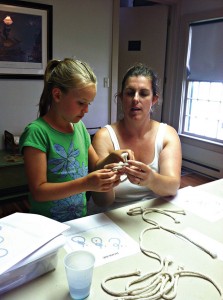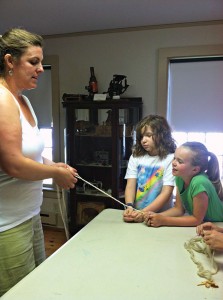The Mattapoisett Historical Society held Part II of their summer program “History by Hand” last Wednesday at the museum. Children ages eight and up were invited to learn through hands-on activities what it was like to live in Mattapoisett roughly 150 years ago. Last week’s program focused on the working aspect of life.
“Around here that involves usually either farming or building ships,” explained museum curator Elizabeth Hutchison.
The afternoon began with how ships were built. Hutchison showed the group of four kids various tools such as a hammer made of wood, a chisel, large nails used to sew sails, and a fid used to break knots. The tools were old and worn, yet well preserved. A few of the tools’ handles bore the carving “mine,” showing the humor of a shipbuilder long ago.
“Part of the program is always to bring the museum’s collection into use, to try to use what we have to help promote history and promote learning,” said Hutchison, “We found some tools that we knew were OK for the kids or for us to demonstrate with.”
Using an old auger, the kids took turns trying to drill a hole into a plank of wood. They realized the intensity of this simple task, as after a few minutes they had drilled just about a third of the way through the plank. Workers would have to drill hundreds of these holes in the process of building a ship.
Again putting the museum’s tools to use, Hutchison demonstrated how to shave and shape wood with a hand plane. Then she showed how one would sharpen an ax, having the kids turn the lever to spin the old, heavy grinding wheel.
Moving onto farming, Hutchison explained the uses of a fan mill, turnip mincer, corn chopper, cider press, and other machines the museum has on display. The kids were attentive – listening, learning, and asking questions.
Next the group went over rope making, and Hutchison described the ropewalks where long strands of material were twisted tightly into ropes. These ropes often were put to use on Mattapoisett’s ships.
“Of course everybody has to know knots when you work on a ship,” said Hutchison, so the kids learned a selection of knots used commonly by sailors. As they practiced knots such as the bowline or the butterfly (which looks more like a spider or a person than a butterfly, the kids decided), Hutchison went over the knots’ uses and origins. She told them about Clifford Ashley, a man from New Bedford who in 1944 published The Ashley Book of Knots, which contains instructions for nearly 4,000 knots.
The kids also got to practice writing with old pens and Indian ink. They carefully scratched away at their papers, holding historic handles made of mother-of-pearl or ivory. “When you talk about the business end of shipbuilding and stores in town and stuff like that, everybody kept ledgers,” Hutchison explained, “and it’s always fun for the kids to try writing with the old pens.”
The last activity of the day was a farming experience. The group talked about where seeds come from and then got to plant some seed pods from daisies and coreopsis flowers.
“Life builds on itself, so it’s good to know where you came from, and how things used to be done. You can think about all the improvements that happen in our daily lives – everybody’s always trying to make something better, because it was hard!” said Hutchison, “It used to be hard, so that’s why inventers invent things.”
Part I of “History by Hand” showed these same principals when it was held on July 9. While Part II focused on the worker’s life, Part I focused on home life. The kids practiced washing with a washboard and they looked at irons and the first washer machines. The kids also looked at what people did before electric vacuums – they had beating rugs and hand-held vacuum cleaners. The group also went over sewing, and the kids did a project where they made bookmarks and sewed on their initials with needle points.
“Kids learn better when they’re doing things, trying things out on their own and kind of exploring more,” said Hutchison.
The Mattapoisett Historical Society upholds this belief in all their programs. While this summer’s program focused on life in early Mattapoisett, previous summer program have allowed kids to discover old-fashioned candy or build boats out of recyclables.
The museum has their Little Explorers program running every Thursday at 1:00 pm until August 7. This ongoing program allows 4, 5, and 6 year olds to explore topics such as farming, pirates, maps, and old-fashioned toys through games and hands-on activities. The program is free, but donations are encouraged. Registration is required.
The Mattapoisett Historical Society is also looking forward to their “Sailor’s Life” program on August 6 at 1:00 pm. Kids are invited to explore life at sea through hands-on activities involving knots and signal flags. They’ll also be able to personalize a ditty bag and sample hard-tack, a type of dry bread eaten by sailors. This event is also free, but donations are encouraged.
“It just good to learn about the past so you know what used to be and how we are where we are today,” said Hutchison. Those with an interest in history may find all adult and kids events listed on the Mattapoisett Historical Society’s website.
By Renae Reints

